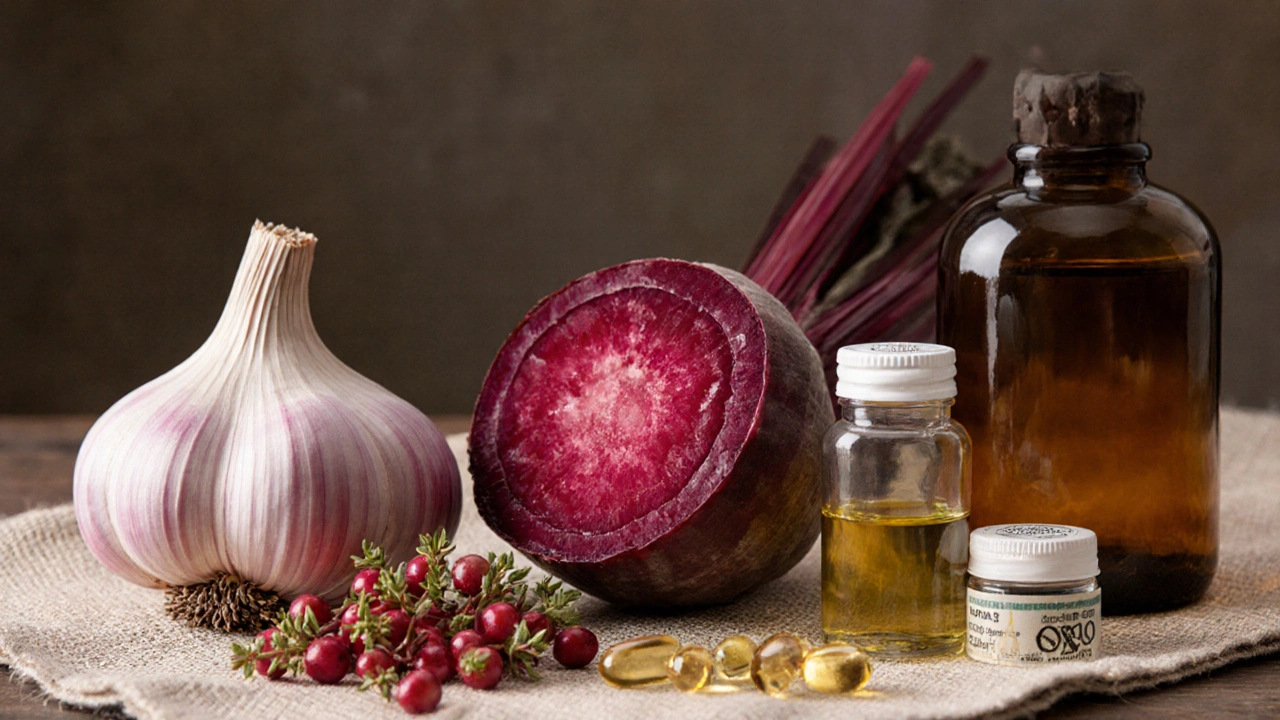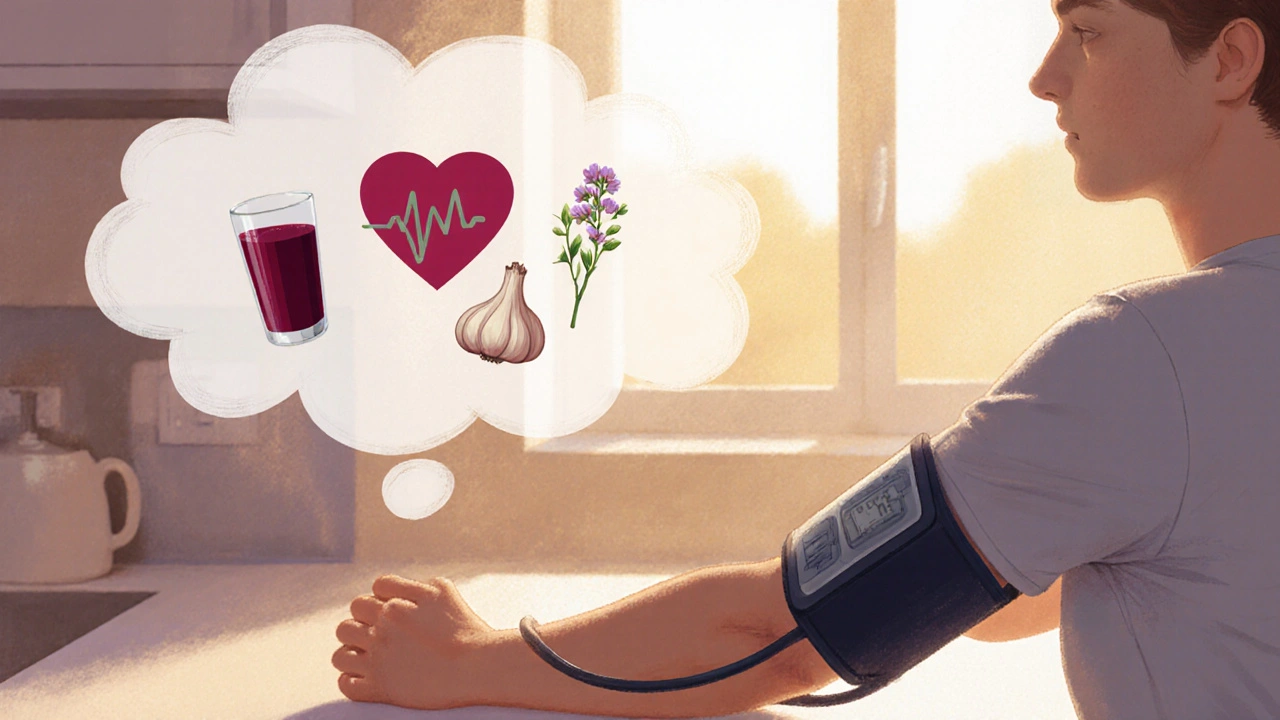Serpina vs Natural Blood Pressure Alternatives
Natural Alternatives Overview
Serpina (Sarpagandha)
Central sympathetic inhibition. Strong evidence but with sedation risks.
-10 to -15 mmHg Fatigue, depressionGarlic
Allicin-induced nitric oxide release. Mild side effects.
-5 to -8 mmHg Bad breathBeetroot
Dietary nitrate to nitric oxide. Fast acting.
-4 to -10 mmHg Red urineHawthorn
Flavonoid-mediated vasodilation. Well-tolerated.
-4 to -6 mmHg GI upsetOmega-3
Anti-inflammatory & membrane fluidity.
-2 to -5 mmHg Fishy tasteCoQ10
Mitochondrial energy support.
-5 to -7 mmHg InsomniaRecommended Approach
Based on your inputs, we recommend starting with Garlic or Beetroot for mild to moderate hypertension. These offer measurable benefits with minimal side effects.
Important Safety Notes
- Serpina may interact with antidepressants and beta-blockers.
- Garlic can increase bleeding risk with anticoagulants.
- Beetroot may cause hypotension when combined with BP medications.
- Always consult your doctor before combining supplements with prescription medications.
When it comes to managing high blood pressure without a pharmacy‑filled bottle, many people turn to herbs that have been used for centuries. Serpina vs alternatives is the question you’re probably asking right now. Below you’ll find a plain‑English breakdown of what Serpina (also called Sarpagandha) actually does, which herbs sit in the same lane, and how to decide which one fits your lifestyle.
Quick Takeaways
- Serpina (Rauwolfia serpentina) lowers blood pressure by dampening nervous system signals.
- Hawthorn, garlic, beetroot, omega‑3s, and CoQ10 are the most studied natural alternatives.
- Evidence for Serpina is strong but safety concerns (sedation, low heart rate) limit long‑term use.
- For mild to moderate hypertension, garlic and beetroot offer modest drops with minimal side effects.
- Always check with a doctor before mixing herbs with prescription meds.
What Is Serpina?
Serpina is a root extract from the plant Rauwolfia serpentina, traditionally used in Ayurvedic and Chinese medicine to treat high blood pressure and anxiety. In the West it’s often sold under the name Sarpagandha. The plant contains alkaloids - mainly reserpine - that deplete certain neurotransmitters (dopamine, norepinephrine, serotonin) in nerve endings, which leads to a calmer, less “spiky” vascular tone.
How Serpina Works
The key action is called “central sympathetic inhibition.” By lowering norepinephrine release, blood vessels relax and the heart beats more slowly. Clinical trials from the 1960s‑80s showed average systolic reductions of 10‑15mmHg, comparable to low‑dose thiazide diuretics. However, the same mechanism can cause side effects such as fatigue, depression, and a dangerously low heart rate if the dose exceeds 0.5mg daily.

Top Natural Alternatives
Below are the herb‑based or nutrient‑based options that show the most consistent blood‑pressure benefits.
Hawthorn (Crataegus) is a shrub whose berries and leaves contain flavonoids and oligomeric proanthocyanidins that improve coronary flow and modestly lower systolic pressure (average 4‑6mmHg). It’s well‑tolerated, but high doses can cause mild GI upset.
Garlic (Allium sativum) supplies allicin, a sulfur compound that relaxes smooth muscle and improves endothelial function. Meta‑analyses of 10+ trials report a 5‑8mmHg systolic drop, especially when taken as a standardized 600mg capsule twice daily.
Beetroot (Beta vulgaris) is rich in dietary nitrate, which the body converts to nitric oxide - a potent vasodilator. A 250ml beet juice shot can reduce systolic pressure by 4‑10mmHg within 90minutes, making it a fast‑acting option.
Omega‑3 Fatty Acids (EPA/DHA) are polyunsaturated fats found in fish oil that lessen inflammation and improve arterial elasticity. Long‑term supplementation (1‑2g daily) typically yields a 2‑5mmHg reduction.
Coenzyme Q10 (CoQ10) is a mitochondrial antioxidant that supports heart muscle energy production. Doses of 100‑200mg per day have been linked to a 5‑7mmHg drop, particularly in patients already on statins.
Side‑by‑Side Comparison
| Entity | Primary Mechanism | Evidence Strength | Typical Dose | Main Side Effects |
|---|---|---|---|---|
| Serpina (Rauwolfia serpentina) | Central sympathetic inhibition via reserpine | Strong (randomized trials, 1960‑80s) | 0.25‑0.5mg daily | Fatigue, depression, bradycardia |
| Hawthorn | Flavonoid‑mediated vasodilation & antioxidant | Moderate (meta‑analysis 2021) | 300‑600mg extract BID | GI upset, rare dizziness |
| Garlic (standardized) | Allicin‑induced nitric oxide release | Moderate‑high (Cochrane 2022) | 600mg capsule BID | Bad breath, mild GI irritation |
| Beetroot juice | Dietary nitrate → nitric oxide | High (acute trials 2023) | 250ml daily | Red urine, beet taste |
| Omega‑3 (EPA/DHA) | Anti‑inflammatory & membrane fluidity | Moderate (systematic review 2020) | 1‑2g fish oil daily | Fishy aftertaste, rare bleeding risk |
| CoQ10 | Mitochondrial energy support | Moderate (RCTs in hypertensive adults) | 100‑200mg daily | Insomnia, mild GI upset |
Choosing the Right Option for You
Think of the decision as a checklist rather than a gamble. Ask yourself these three questions:
- How severe is my hypertension? If your systolic is consistently over 160mmHg, you’ll likely need a prescription drug first. Natural agents can act as adjuncts.
- Do I have any chronic conditions or meds? Serpina’s interaction with antidepressants or beta‑blockers makes it risky for many people, while garlic and omega‑3 are generally safe.
- What side‑effect profile am I comfortable with? If you can tolerate mild fatigue, Serpina might be acceptable short‑term. If you prefer “no‑sedation,” beetroot or hawthorn are safer bets.
For most adults with stage1 hypertension (130‑139mmHg systolic), starting with garlic or beetroot provides a measurable dip without the need for close monitoring. If you enjoy a daily tea, hawthorn extract can double as a heart‑friendly tonic.
Potential Risks & Interactions
Natural doesn’t equal risk‑free. Here are the top red flags you should watch for:
- Serpina + antidepressants: Both lower serotonin; combine and you could trigger severe depression.
- Garlic + anticoagulants (warfarin, aspirin): Garlic can increase bleeding time.
- Omega‑3 + blood thinners: Similar bleeding risk; keep dosage under 2g unless your doctor says otherwise.
- Beetroot + low blood pressure meds: The combined effect might push you into hypotension, causing dizziness.
Always discuss any new supplement with your primary care physician, especially if you’re already on ACE inhibitors, beta‑blockers, or diuretics.

Frequently Asked Questions
Can I replace my prescription blood‑pressure drug with Serpina?
Only under strict medical supervision. Serpina works well for mild hypertension, but it can cause low heart rate and interacts with many meds. Most doctors will keep the prescription and add a low‑dose herb as a supplement.
How long does it take for beetroot juice to lower my blood pressure?
Peak nitrate‑derived nitric oxide appears within 1‑2hours, and the effect can last up to 6hours. Many people drink a 250ml shot before an afternoon meeting for a quick boost.
Is hawthorn safe for people with atrial fibrillation?
Hawthorn can affect cardiac conduction, so people with irregular rhythms should use it only after a cardiologist clears it. Low doses (150mg BID) are less likely to cause problems.
What dosage of garlic supplement is backed by research?
Most high‑quality trials used 600mg of aged garlic extract (standardized to 1.3% allicin) taken twice daily. This regimen consistently showed a 5‑8mmHg systolic drop.
Can I take CoQ10 and a statin together?
Yes, and it’s actually common. Statins can lower natural CoQ10 levels, so supplementing 100‑200mg daily often improves muscle pain and adds a modest blood‑pressure benefit.
Bottom line: Serpina offers a powerful, prescription‑like drop in blood pressure but brings a heavier side‑effect load. Garlic, beetroot, hawthorn, omega‑3, and CoQ10 give gentler, more tolerable reductions and can be safely layered with conventional meds under a doctor’s watch. Pick the one that matches your health profile, taste preferences, and tolerance for monitoring, and you’ll be on a clearer path to a calmer heart.


Comments (11)
Ajay D.j
I've been using beetroot juice for a few months and notice my morning BP sits a few points lower, especially after a 250ml shot with a pinch of lemon.
The nitrate kick works fast, so it’s great when I'm stressed at work.
Dion Campbell
In the grand tapestry of cardiovascular management, one cannot simply whisk away the nuances of herb‑driven therapy with a careless swipe.
While the data on garlic and beetroot are respectable, the seductive allure of “natural” often masks the gritty reality of dosage variability.
Moreover, the seductive promises of Serpina echo the same old drama of old‑world pharmacology, where the line between miracle and menace blurs under the weight of anecdote.
Burl Henderson
Adding to Ajay's point, several meta‑analyses published after 2020 show that a daily 600 mg aged garlic extract can cut systolic pressure by roughly 6 mmHg on average.
That figure aligns nicely with the beetroot data you mentioned, giving users a choice between a quick nitrate surge and a steadier allicin effect.
Leigh Ann Jones
When I first read about Serpina, I imagined a sleek, modern pill that could replace my prescription, but the reality is far more intricate.
\nThe alkaloid reserpine, while powerful, also depletes serotonin and dopamine, which is why many patients report a lingering sense of fatigue that can border on depression.
In my own case, a low dose of 0.25 mg gave me a modest 8 mmHg drop, yet after a few weeks I felt unusually drowsy, prompting a doctor visit.
My physician reminded me that the central sympathetic inhibition works systemically, affecting not only blood vessels but also heart rate, sometimes pushing it into bradycardia territory.
Contrast that with garlic, which exerts its effect primarily through endothelial nitric oxide pathways, producing a gentler vasodilation without the central nervous system sedation.
Beetroot, on the other hand, offers a rapid, short‑term nitrate‑derived nitric oxide surge that can lower systolic pressure within an hour, making it attractive for situational spikes, such as before a high‑stress meeting.
The side‑effect profile of beetroot is largely limited to the occasional reddish urine, which many find amusing rather than alarming.
Hawthorn provides flavonoid‑mediated vasodilation and is well tolerated, though its impact is modest-typically a 4‑6 mmHg reduction.
Omega‑3 fatty acids bring anti‑inflammatory benefits that improve arterial compliance, but the BP shift is usually only 2‑5 mmHg, making them a supportive rather than primary agent.
CoQ10’s role in mitochondrial energy production can help patients on statins avoid muscle pain while also nudging BP down by about 5 mmHg, but insomnia is a reported concern for some.
Overall, my takeaway is that natural agents are best viewed as complementary tools rather than outright replacements for prescription therapy.
Each herb or nutrient carries its own mechanism and side‑effect spectrum, so matching the choice to your personal health context-current medications, tolerance for sedation, and lifestyle preferences-is essential.
Always involve your healthcare provider when layering these supplements, especially if you’re already on beta‑blockers or anticoagulants.
Sarah Hoppes
They don’t tell you that the pharma lobby pushes the narrative that all herbs are safe.
Look at the hidden clauses in the supplement bills.
Robert Brown
Garlic can’t cure hypertension.
Erin Smith
Hey folks! Just wanted to say that adding a little beetroot to your morning smoothie can be a fun way to keep your pressure in check.
It’s tasty, easy, and you’ll feel great.
George Kent
Beetroot is *awesome*!! 🌟
Just make sure you don’t overdo it or you’ll turn your pee into a crime scene.
Jonathan Martens
Honestly, the whole “natural vs prescription” hype feels like a circus act where the clowns keep swapping hats.
If you’re looking for a real solution, start with a solid diet, move to proven supplements, and only then consider prescription meds under a doc’s watch.
Jessica Davies
While the theatrics are entertaining, the truth is that many of these herbal options have barely scratched the surface of rigorous testing.
Don’t be fooled by glossy marketing.
Kyle Rhines
Grammar check: Garlic dosage 600 mg BID is backed by multiple RCTs; beetroot 250 ml daily shows acute BP reduction of up to 10 mmHg.
Both are safe when not combined with anticoagulants.